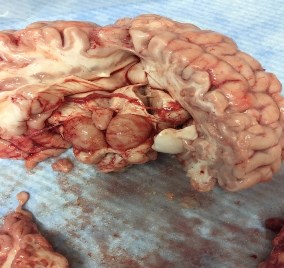Rabies Virus
Did you know? The Delaware Public Health Laboratory (DPHL) is the only rabies virus laboratory for the state of Delaware.
Rabies virus is transmitted to humans via through the bite or scratch of a rabid mammal. Rabies infects the central nervous system with early symptoms of fever, headache, and malaise that progress to paralysis, hyper-salivation, and even hydrophobia (fear of water). Rabies is usually fatal in humans (CDC, 2018).
Delaware experienced its first human rabies case since 1941 in August 2018. The Kent County woman was probably infected in July 2018, and admitted to a Delaware hospital. As her condition deteriorated, she was transferred to a Philadelphia area hospital where she subsequently passed away. It is still unknown how she contracted the virus (Newman, 2018).
What We Do:

- DPHL ONLY tests animal brains on animals that have exposed humans to their saliva.
- The Office of Animal Welfare (OAW) will collect the animal, by dispatching an Animal Control Officer.
- The animal is euthanized and transferred to the Delaware Department of Agriculture, where it is decapitated.
- The head is submitted for testing at DPHL, where the brain is removed for testing.
- Sections of the brain stem and cerebellum are affixed to slides and stained with a fluorescent-labeled rabies antibody.
- If the virus is present, antigen in the brain will bind to the antibody and will be visibly fluorescent under a microscope.
Submitting a Specimen
- Specimens must be submitted through the Division of Public Health’s Office of Infectious Disease Epidemiology (OIDE).
What can you do to Prevent Rabies Virus?
- Keep rabies vaccinations current for all pets.
- Maintain control of your pets outside and keep dogs under direct supervision.
- Spay or neuter your pets to reduce the prevalence of unwanted/feral animals.
- Contact the OIDE immediately if you think you have been exposed to a wild or potentially rabid animal (CDC, 2018). Those exposed have a ten-day window to receive prophylactic treatment for rabies virus.
Links:
Office of Infectious Disease Epidemiology
Delaware Department of Agriculture
References:
Centers for Disease Control and Prevention. (2018). Rabies.
Return to the Molecular Virology home page.
Return to the Delaware Public Health Laboratory home page.
This page was last updated 4/2024
![]() Please note: Some of the files available on this page are in Adobe PDF format which requires Adobe Acrobat Reader. A free copy of Adobe Acrobat Reader can be downloaded directly from Adobe . If you are using an assistive technology unable to read Adobe PDF, please either view the corresponding text only version (if available) or visit Adobe’s Accessibility Tools page.
Please note: Some of the files available on this page are in Adobe PDF format which requires Adobe Acrobat Reader. A free copy of Adobe Acrobat Reader can be downloaded directly from Adobe . If you are using an assistive technology unable to read Adobe PDF, please either view the corresponding text only version (if available) or visit Adobe’s Accessibility Tools page.



